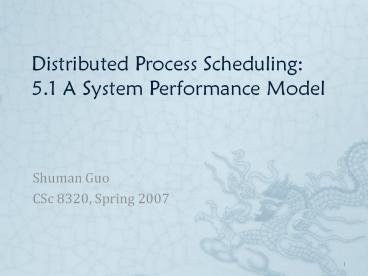Distributed Process Scheduling: 5.1 A System Performance Model - PowerPoint PPT Presentation
Title:
Distributed Process Scheduling: 5.1 A System Performance Model
Description:
RC: Relative concurrency. How far from optimal the usage of the n-processor is. RC=1 best use of the processors ... and traffic lights, trucks or ships waiting ... – PowerPoint PPT presentation
Number of Views:390
Avg rating:3.0/5.0
Title: Distributed Process Scheduling: 5.1 A System Performance Model
1
Distributed Process Scheduling 5.1 A System
Performance Model
- Shuman Guo
- CSc 8320, Spring 2007
2
Outline
- Overview
- A System Performance Model
- Processor Pool and Workstation Queuing Models
- References
3
OverviewRandy Chow, 97
- Before execution, processes need to be scheduled
and allocated with resources - The objective of scheduling
- Primary Enhance overall system performance
metrics - Process completion time and processor utilization
- Secondary achieve location and performance
transparencies - This chapter presents a model for capturing the
effect of communication and system architectures
on scheduling.
4
Outline
- Overview
- A System Performance Model
- Processor Pool and Workstation Queuing Models
- References
5
A System Performance Model
- We used graph models to describe process
communication.
Four processes mapped to a two-processor multiple
computer system
6
Process Models
- Precedence process model
- Represent precedence relationships between
processes - Minimize total completion time of task
(computation communication) - Communication process model
- Represent the need for communication between
processes
7
Process Models contd
- Optimize the total cost of communication and
computation - Disjoint process model
- Processes can be run independently and completed
in finite time - Maximize utilization of processors and minimize
turnaround time of processes
8
System Performance Model
Attempt to minimize the total completion time of
(makespan) of a set of interacting processes
9
System Performance Model contd
- Related parameters
- OSPT optimal sequential processing time
- CPT concurrent processing time
- OCPTideal optimal concurrent processing time on
an ideal system - Si ideal speedup obtained by using a multiple
processor system over the best sequential time - Sd the degradation of the system due to actual
implementation compared to an ideal system
10
System Performance Model (Cont.)
Pi the computation time ofthe concurrent
algorithm onnode i
(RP ? 1)
11
System Performance Model contd
(The smaller, the better)
12
System Performance Model contd
- RP Relative processing
- Shows how much loss of speedup is due to the
substitution of the best sequential algorithm by
an algorithm better adapted for concurrent
implementation but which may have a greater total
processing need - Sd
- Degradation of parallelism due to algorithm
implementation
13
System Performance Model contd
- RC Relative concurrency
- How far from optimal the usage of the n-processor
is - RC1 ? best use of the processors
- ? Efficiency Loss is loss of parallelism when
implemented on a real machine. - ? can be decomposed into two terms
- ? ?sched ?syst
14
Workload Distribution
- Performance can be further improved by workload
distribution - Load sharing static workload distribution
- Dispatch process to the idle processors
statically upon arrival - Corresponding to processor pool model
- Load balancing dynamic workload distribution
- Migrate processes dynamically from heavily loaded
processors to lightly loaded processors - Corresponding to migration workstation model
15
Queuing Theory
- Performance of systems described as queuing
models can be computed using queuing theory. An
X/Y/c queue is one where - X Arrival Process, Y Service time distribution,
c Numbers of servers - ? arrival rate ? service rate ? migration
rate - ? depends on channel bandwidth, migration
protocol, context and state information of the
process being transferred.
16
Processor-Pool and Workstation Queueing Models
Static Load Sharing
Dynamic Load Balancing
M for Markovian distribution
17
Examples of Real World Queuing Systems? Lawrence
Commercial Queuing Systems Commercial
organizations serving external customers Ex.
MedicalHuang,07, bank, ATM, gas stations,
plumber, garage Transportation service
systems Vehicles are customers or servers Ex.
Vehicles waiting at toll stations and traffic
lights, trucks or ships waiting to be
loadedYeon,07 ,taxi cabs, fire engines,
elevators, buses
18
Examples contd
- Business-internal service systems
- Customers receiving service are internal to the
organization providing the service - Ex. Inspection stations, conveyor belts, computer
support - Social service systems
- Ex. Judicial process, the ER at a hospital,
waiting lists for organ transplants or student
dorm rooms
19
References
- 1 Randy Chow Theodore Johnson,
1997,Distributed Operating Systems
Algorithms, (Addison-Wesley), p. 149 to 156. - 2 Stephen Lawrence.Queuing Simulation.
http//209.85.165.104/search?qcachehCreyAHJ8WgJ
leedsfaculty.colorado.edu/lawrence/SYST4060/Lectur
es/6a25202520Intro2520to2520Queueing.pptqueui
ngsimulationpptlawrencehlenctclnkcd1glu
s - 3 Yeon, Jiyoun Ko, Byungkon. Comparison of
Travel Time Estimation Using Analysis and Queuing
Theory to Field Data Along Freeways. Multimedia
and Ubiquitous Engineering, 2007. MUE 07
International Conference onApril 2007
Page(s)530 - 538 . - 4 Ean-Wen Huang Der-Ming Liou. Performance
Analysis of a Medical Record Exchanges Model.
Information Technology in Biomedicine, IEEE
Transactions on March 2007 Page(s)153 - 160
20
Thank you!
- Any questions?































